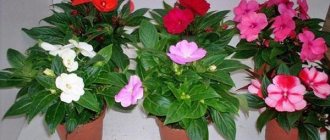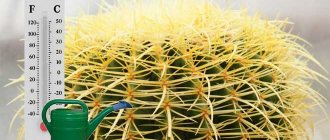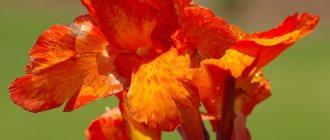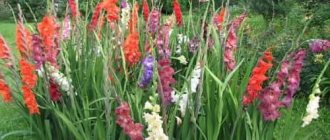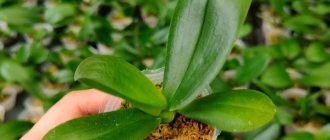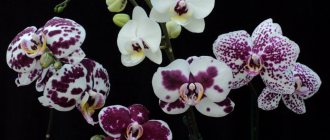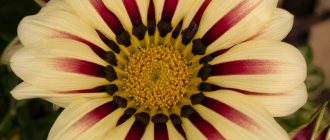Plants » Flowers
0
1526
Article rating
Kira Stoletova
In order for orchids to grow well and bloom for a long time, they need to be provided with proper care and the right living conditions. One of the requirements for caring for a plant is watering. Watering features vary depending on the time of year and the period of life of the flower. Watering your orchid in winter is the most important part of care.
Features of watering orchids in winter
How often should I water in autumn and winter?
When caring for orchids, you need to remember that they do not like excess moisture in the pot (how to water an orchid growing in a pot?). It is better to dry the soil a little rather than flood it. How often you need to water the plant at home in winter depends on how quickly the soil dries out (read here about how to water your home orchid at any time of the year). Usually this is once a week.
However, watering may be needed even less frequently. It depends on the conditions in which the orchid is kept. The colder and darker the room, the slower the soil dries out. So the interval between watering can increase to 10, and sometimes up to 14 days.
Reference. There is no need to rush to water the orchid if the soil has dried out on top. As a rule, the soil at the depth of the pot is still wet. It is better to postpone the procedure for another one or two days.
The most effective way to determine the level of soil drying is to place a wooden skewer into the pot. If it becomes wet, then it is too early to water the orchid.
It is convenient to monitor the drying of the soil if the orchid grows in a transparent pot. In this case, you need to water it when condensation stops collecting on the pot. The color of the roots is also an indicator of soil drying out: you should water the orchid when the roots become lighter. If the roots are green, watering should be postponed.
How often orchids need to be watered is discussed in a separate article.
Frequency and abundance
During the cold season, the orchid does not go into complete hibernation, so it is not recommended to completely stop watering. Only the frequency of irrigation and the amount of fluid per single procedure are reduced.
Experienced gardeners advise moistening the substrate once every 10 days or even 2 weeks. You should not strictly adhere to these rules; the main guideline is the state of soil moisture.
Reference! Do not let the substrate dry out too much. Overmoistening also has a negative effect on plant development. Therefore, the irrigation process is controlled individually, taking into account the microclimate in the room.
Water preparation
The water for watering the orchid should be warm. It is enough to simply draw water from the tap in advance, at least a day in advance, and leave it to infuse in an open container. This will allow the water to reach a comfortable room temperature and evaporate substances harmful to plants contained in tap water. However, if the room is cool, it is better to heat the water a little so that it reaches a temperature no higher than 30 0C.
In winter, the need for fertilizing is reduced. Therefore, you should not fertilize the plant before spring. An exception may be the case when the orchid is under special artificial lighting.
Read about how to water an orchid and how often it can be done here.
Placement of the flower
The location of the flower pot plays an important role in winter. If the plants are on the windowsill, you need to protect them from hypothermia. To do this, the pots are placed in a plastic container that has a raised area at the bottom.
This will allow excess water to freely leave the pot, preventing the roots from becoming waterlogged. It is also important to create thermal protection against the flow of cold air coming from the window. To do this, it is enough to install a foam plate between the flower and the glass. The height of the barrier corresponds to the parameters of the pot with a slight increase.
Reference! The absence of stagnant moisture in the soil reduces the risk of developing fungal infections.
detailed instructions
There is an opinion that you should not wash the orchid in the shower or spray it in the cold season. However, first of all you should be guided by the condition of the plant. If the plant feels good, then it is really better to postpone such watering methods to a warmer time.
From September to November
During the fall months, you can use the submersion method for watering. To do this you need:
- Place the orchid pot in an empty container slightly larger than the pot itself.
- Pour water into the orchid pot. It is important to pour not directly on the roots, but on the substrate.
- Water until the water level in the outer container reaches ¾ of the height of the orchid pot.
- Leave the pot in the water for half an hour.
- Remove the pot and place it on a tray. This will allow excess moisture to drain. Leave it like this for 20 minutes.
- After 20 minutes, drain the excess water and place the orchid in its permanent place.
Recommendation. You can place the orchid pot directly in a bowl of water. In this case, you need to hold it so that the flower does not turn over and the substrate does not spill out of the pot. Dry bark is very light and will not hold the pot at the bottom of the basin. He might just float up.
From December to February
In winter, you can also water an orchid using the immersion method (what other methods of watering orchids are there?). However, it is worth paying attention to the general air humidity.
If the room is very dry, you need to provide additional humidification. To do this you can:
- Place a humidifier in the room.
- Spray the air around the orchid with a spray bottle. The main thing is not to get on the rosettes of leaves.
- You can place a container of water next to the orchid so that it evaporates smoothly.
- If the orchid is located next to the radiator, you can place a damp towel on the radiator and change it as it dries.
Lighting
Another important factor in orchid farming is lighting. Daylight hours are significantly reduced as cold weather approaches. There is a need for additional lighting. It is recommended to purchase a fluorescent lamp with a cold or warm glow.
Its power should be approximately 60 watts. The light source is placed at a distance of 30-40 cm from the flower. The operating mode of the lighting device is selected depending on the length of daylight hours. The plant needs 12 hours of daylight (from 8-00 to 20-00). With a lack of lighting, the leaves begin to wrinkle and their color fades.
What difficulties arise?
Most often, problems with watering orchids in the cold season are caused by excess moisture. The orchid does not like the cold, and moisture in the pot can cause hypothermia of the roots and, as a result, their rotting and fungal diseases. To avoid this, be sure to let the water drain well after watering and remove it from the pan in time.
To avoid such problems, you need to ensure the thermal insulation of the flower. You can move it from the windowsill to a warmer place. But then you need to take care of good lighting. If there is nowhere to move the pot, you can lay a layer of foam under it or use it to block the pot from drafts.
At first glance, it may seem that the orchid is very whimsical. However, to care for it you need to follow fairly simple rules that even a novice gardener can handle. The main thing is to be attentive to your flower and act only based on its needs. With careful handling, the orchid will delight you with its flowering in the middle of a cold winter (how to water it during flowering?).
Proper watering is very important for any plant, and especially for the fastidious orchid. Therefore, if you are going to grow such a flower at home, be sure to read about how to water it correctly, including after transplanting it into another pot.
Watering
One of the main requirements is to reduce the frequency and dose of watering. Violation of this rule leads to the fact that the root system simply will not have time to absorb the usual amount of water. As a result, the root shoots rot.
To control the degree of plant moisture, gardeners periodically inspect the roots. A slightly lilac color or light green tone indicates a healthy root system. Dark wet islands indicate the beginning of the rotting process. If the color of the root shoots is gray, the orchid needs watering.
Orchid care basics
When caring for a plant, certain requirements must be observed:
- Light mode. The plant loves light (with the exception of direct sunlight). The best option is a distance of no closer than one meter to the window. If there is not enough light for the flower, then the leaves will actively grow, and the “dormant” buds will not bloom.
- Humidity mode. Since orchids are tropical plants, one of the conditions for their normal growth is high humidity. Dry indoor air can cause leaves to wilt.
- Temperature conditions. The most favorable temperature for a flower is +17…+23 degrees. Excessive heat adversely affects its flowering: this period is significantly reduced.
- Proper watering. Excessive watering can lead to rotting of the root system and falling buds. For irrigation, you need to use settled water not lower than +35 degrees.
- Fertilizers. Fertilizing should be carried out no more than once every 7–10 days (flowering period) with fertilizers that contain potassium, nitrogen, and phosphorus.
- A change of scenery. It is not recommended to move the plant from place to place, especially during the flowering period.
Peculiarity! The duration of flowering is affected by the age of the orchid. Good flower stalks are formed in a plant that is 1.5–3.5 years old.
After the purchase
After buying a flower, a short quarantine is organized. The essence of the event is to keep the orchid separately from other indoor crops. It is also worth excluding:
- direct exposure of the plant to sunlight;
- introduction of fertilizing;
- watering during the first 5-7 days.
Quarantine is necessary to identify harmful insects or a disease dangerous to other plants. After the end of the inspection period, the flower is placed on the windowsill and irrigated if no pathology was detected.
Reference! Watering orchids after purchase is carried out only after the end of quarantine.
Possible problems
- Improper watering can lead to disastrous consequences for the plant. Do not allow water to stagnate in the pan or in the substrate.
- The frequency of watering should be reduced, since in the autumn-winter period the need for water in flowers is noticeably reduced.
- Watering the orchid with cold water is not allowed - you can instantly destroy the roots.
- At this time of year, it is useful to focus on humidifying the air in the room and think about lighting.
Orchid is a beautiful tropical plant that attracts people with its grace and beauty. However, in order to maintain health and ensure full growth, as well as lush flowering, you need to familiarize yourself with the basic rules for caring for an exotic beauty.
The orchid is different from most flowers grown in pots. This plant is an epiphyte that lives on a tree and absorbs moisture from the air. In this case, the orchid is not able to absorb nutrients from the substrate.
The tips given in this article will help a novice gardener understand the nuances of keeping an orchid and warn against mistakes associated with improper watering.
During the rest period
The rest period after flowering is not pronounced in phalaenopsis. But during the cold season, many varieties slow down in development, which is due to natural processes. The frequency of watering is reduced. Particular attention is paid to the irrigation method. When introducing liquid, you should not direct the stream at the plant itself, especially at the center of the outlet. This is fraught with rotting of the flower.
An indicator of the plant's transition to a dormant state is the tips of the roots. A uniform brown color indicates the beginning of rest. Irrigation is carried out no more than once every 14-15 days. As soon as the tips of the root shoots turn green, the plant returns to intensive vegetation. At this stage, the full irrigation regime is restored.
Reference! At stable low temperatures (15-16°) and high humidity, the plant should be watered no more than once a month.
